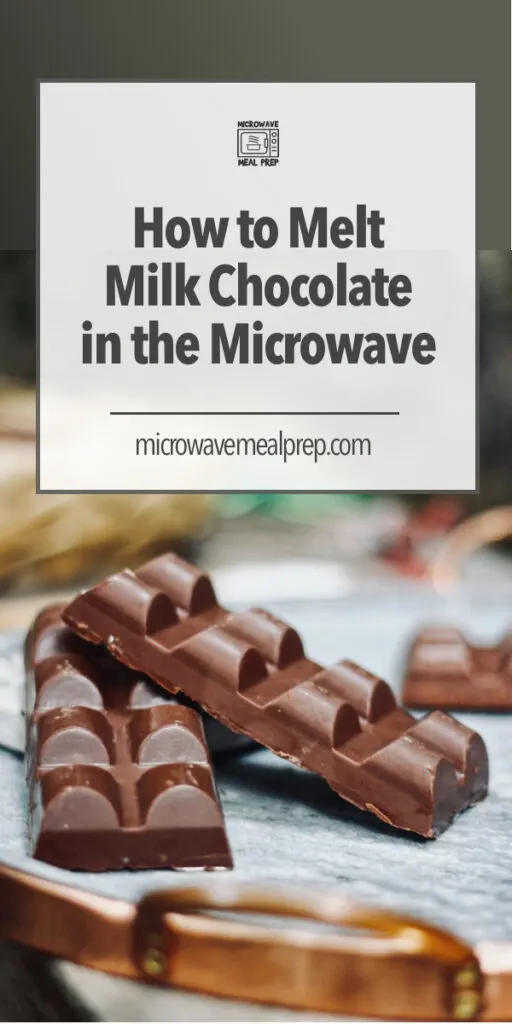Have you tried to melt milk chocolate in the microwave without burning, crystalizing or overheating? Take your baking skills to the next level with the ultimate guide to melt chocolate in the microwave so that you can easily accomplish any chocolatey recipe you desire.
Milk chocolate is made with added milk, sugar and flavorings, which results in sweeter chocolate with a lower percentage of cocoa solids. So, can you melt milk chocolate in the microwave?
Start by breaking the milk chocolate into small pieces and place them in a microwave-proof bowl. Melt in 15 second intervals on medium power level and stir after each duration. Never heat for longer periods because milk chocolate has a lower melting point and melts quickly.
Milk chocolate reacts to heat differently than dark chocolate, semi sweet and white chocolate, therefore you need the specific temperature to melt milk chocolate to avoid overheating and seizing. So, what is the milk chocolate melting point?
At what temperature does milk chocolate melt and for how long?
The general rule while melting chocolate is that the lighter the color the lower the melting point. As a result, the melting point of white chocolate is less than milk chocolate, and milk chocolate is lower than dark chocolate.
Milk chocolate melts at about 86 to 90 degrees Fahrenheit, and you should never heat above these temperature due to the risk in burning or crystalizing the chocolate.
Depend on the amount of milk chocolate you are melting, microwaving time may vary. In general, milk chocolate should take less than a minute to completely melt with 50% microwave power setting.
How do you melt milk chocolate in the microwave without burning it?
The key to melt milk chocolate in the microwave without burning is to not exceed 90 degrees Fahrenheit when its melting.
The easiest way to control the temperature of the melting milk chocolate is to use a low to medium microwave power. Melting chocolate slowly helps to keep the temperature at a consistent level and avoid rapid changes in heat that cause overcooking.
Keep checking the thermometer when taking out from the microwave and stir constantly to find the smooth texture. Use carryover cooking to melt the milk chocolate using the heat energy stored in the bowl.
Burnt chocolate tastes extremely bitter and cannot be used, so always take it slow and microwave milk chocolate cautiously.
Why is my melting chocolate so thick?
Whether you are melting milk chocolate as it is, or adding other ingredients to speed up the process, sometimes melting chocolate come out with a thick texture. So, what is causing the melted chocolate to thicken?
The reason why the chocolate becomes thick is that the milk chocolate is overheated. When milk chocolate overcooks, it becomes thick and lumpy.
The best way to thinning milk chocolate is with the addition of a fat. Adding a spoonful of oil, butter, or shortening can thin out the melting chocolate.
The amount of oil you need will actually determine based on the thickness of your chocolate and your desired consistency. Start with a small amount and stir, incrementally add more if needed.
Things to know before melting milk chocolate in the microwave
Whether you have chocolate bar or chocolate chips, always use high-quality baking style to create a nice smooth drizzle. And if necessary, chop the milk chocolate bar into small sized pieces to melt evenly in the microwave and avoid burning or seizing.
Here are things you need to know before melting milk chocolate in the microwave:
- Make sure to chop in uniform pieces or use milk chocolate chips to melt easily in the microwave.
- Never add water when melting chocolate. Instead, heat up the liquid first, then add the chocolate. The milk chocolate will melt evenly and disperse into the liquid.
- Once the milk chocolate has melted, remove it from microwave immediately and stir the sides to prevent overheating from carryover cooking.
- Add 1 tablespoon of shortening per cup of milk chocolate to create a shiny coating when it hardens.
- Use a glass bowl that is microwave-safe instead of plastic or ceramic.
Chop the milk chocolate into tiny uniform sized pieces to promote even melting in the microwave. Place the bits in a microwave safe bowl, set to medium power level and nuke for 15 second increments.
Stir after each microwaving session and repeat the process until most of the chocolate is melted. Stir to use carryover cooking to fully melt the rest of the milk chocolate.
When melting milk chocolate, do not rush the process because it tends to burn easily. Follow the microwave melting method wisely to prepare your liquified dessert on time.

